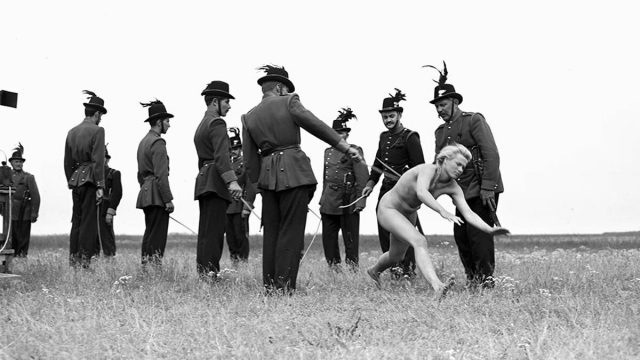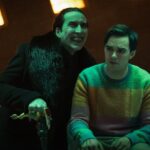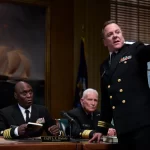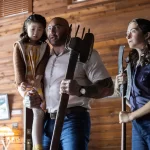Six Films by Miklos Jancso: Once Upon a Time in Hungary, by David Bax

Six films by Miklós Jancsó have recently been restored by Kino Lorber and are currently playing in a retrospective series at the American Cinematheque at the Los Feliz 3. That’s six more Jancsó films that I had seen before last week and watching them in chronological order (not the order of the retrospective) gave me the impression of a filmmaker who started off with a distinct voice and a fully matured sense of style and then, not content with that, pushed himself and his art to stranger and more adventurous places. Like any auteur, though, some of his touchstones would remain with him throughout his developing career. One of the first things you’ll notice is the vast landscape, the Hungarian steppe known as the puszta, which he shoots in a widescreen manner reminiscent of Westerns. That’s especially true of 1966’s The Round-Up, with angular photography that brings to mind Sergio Leone, even if that film and 1967’s The Red and the White are in black and white, while the remaining four are in color.
Along with those beautiful black and white images, the casual cruelty displayed in The Round-Up and The Red and the White makes the two films feel like The Painted Bird had it been directed by an adult. In The Round-Up, those in power—guards and administrators of a prison camp—play games with the lives of their prisoners, pitting them against one another for minor gains. Jancsó’s politics and distrust of authority will come up again and again but, in these two films, there’s a fatalist sense of humor to it. Like Armando Ianucci’s The Death of Stalin, we chuckle bitterly at senseless murders and then scornfully at the implication that brutality won’t actually win the day. Still, cold comfort for the brutalized.
The Red and the White, set amid the Russian Revolution, is the starkest example on offer of Jancsó’s methodology of presenting both sides of a military or political conflict and, while clearly favoring one over the other, nevertheless depicting all involved as human, fallible and corruptible. In other words, in films like that one and 1972’s Red Psalm, it’s clear who the good guys are but they’re never as good as you’d want them to be. To what extent the actual politics of his films are Jancsó’s or those of the communist government under which these six films were produced would require the kind of extratextual detail I generally try to keep out of film reviews. But I wouldn’t blame you for looking up the historical backgrounds of the generally Hungarian-specific periods and settings of some of his films, like 1969’s Winter Wind (which takes place in the time leading up to the 1934 assassination of Yugoslavia’s King Alexander and involves complicated particulars of both nationality and ethnicity) and Red Psalm (drawing inspiration from peasant revolts of the late 1800s).
Politics and ideology are not necessarily the same thing, though. If any single, deeply held belief of Jancsó’s shines through again and again, it is the conviction that idealists, once having gained power, will more than likely compromise their beliefs to hold onto it. This is often to the great detriment of those stubborn enough to hold fast to their stated principles. Winter Wind covers this ground too but Jancsó’s most devastating indictment comes in 1968’s The Confrontation (his first color film), in which a group of students from a communist college come to a seminary to debate the students there but end up tearing themselves apart instead.
Okay, that’s enough politics. Let’s talk form instead, a mode in which these six films are every bit as rich, a truth especially evident in these new restorations. Jancsó’s signature move is the long take, a technique he keeps stretching as the years progress. 1974’s Electra, My Love—the latest film represented in the retrospective—consists of only twelve takes in total. But these aren’t long takes of the “just keep rolling” variety. They are precisely timed and choreographed, with large numbers of moving bodies (often both human and equine) swirling in and out of the frame. The opening take of The Red and the White tells at least three separate stories before the first cut. Jancsó achieves what are essentially separate set-ups within each take in the same manner as the late Raoul Ruiz. As the films go on, these takes become more languid and dreamlike but the mastery of technique has been established.
Jancsó’s films themselves become more oneiric as they transition for unblinking realism to allegory. Red Psalm ventures heavily into this territory, with images like a peasant woman firing a single revolver and felling an entire company of soldiers. For what it’s worth, the films also increasingly feature nude women, an evergreen hallmark of the celebrated male arthouse director. Electra, My Love is the pinnacle of both developments, reinterpreting the Electra myth to illustrate the corruption of the Hungarian Communist Party. We’ve left the plane of reality but we haven’t left the plains of Hungary. Groups of people linking arms and swaying feels right at home in the theatrics of a Greek tragedy but it’s also how the students in The Confrontation celebrate their cause. Each of these six films is powerful on their own. Taken as a group, they are an argument for a world-class auteur with a singular point of view.





























